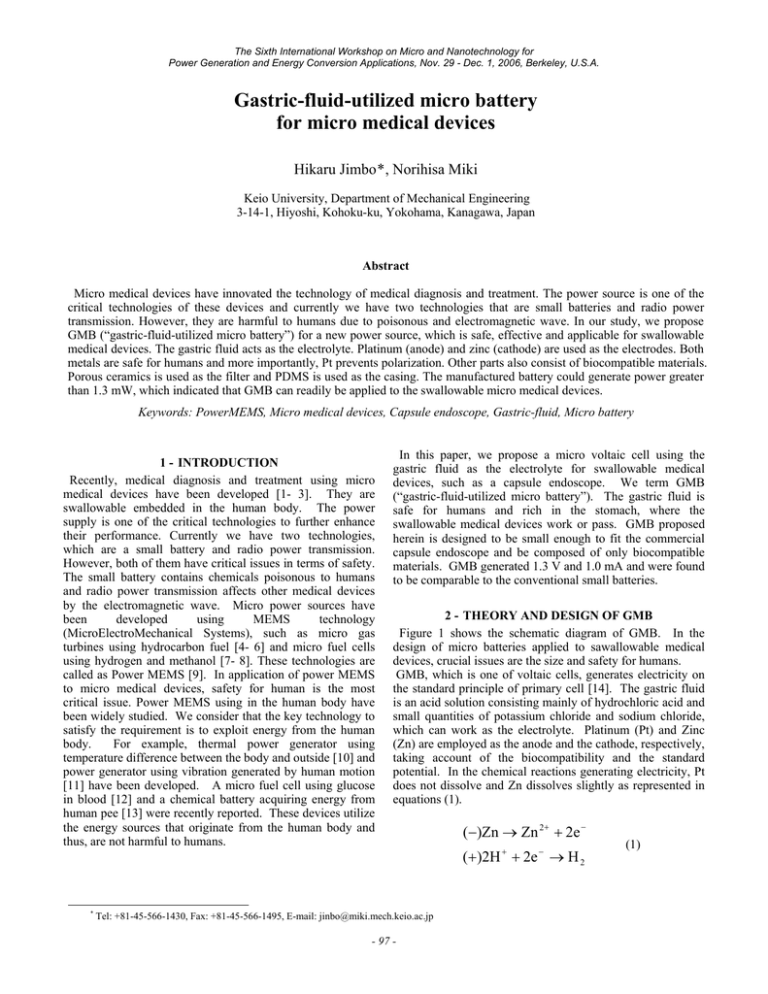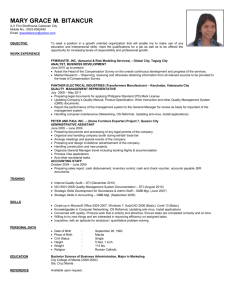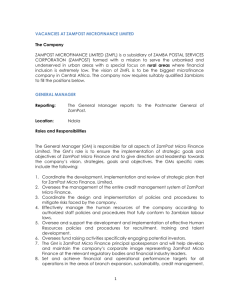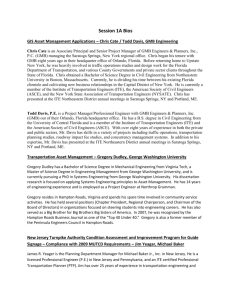Gastric-fluid-utilized micro battery for micro medical devices *
advertisement

The Sixth International Workshop on Micro and Nanotechnology for Power Generation and Energy Conversion Applications, Nov. 29 - Dec. 1, 2006, Berkeley, U.S.A. Gastric-fluid-utilized micro battery for micro medical devices Hikaru Jimbo*, Norihisa Miki Keio University, Department of Mechanical Engineering 3-14-1, Hiyoshi, Kohoku-ku, Yokohama, Kanagawa, Japan Abstract Micro medical devices have innovated the technology of medical diagnosis and treatment. The power source is one of the critical technologies of these devices and currently we have two technologies that are small batteries and radio power transmission. However, they are harmful to humans due to poisonous and electromagnetic wave. In our study, we propose GMB (“gastric-fluid-utilized micro battery”) for a new power source, which is safe, effective and applicable for swallowable medical devices. The gastric fluid acts as the electrolyte. Platinum (anode) and zinc (cathode) are used as the electrodes. Both metals are safe for humans and more importantly, Pt prevents polarization. Other parts also consist of biocompatible materials. Porous ceramics is used as the filter and PDMS is used as the casing. The manufactured battery could generate power greater than 1.3 mW, which indicated that GMB can readily be applied to the swallowable micro medical devices. Keywords: PowerMEMS, Micro medical devices, Capsule endoscope, Gastric-fluid, Micro battery 1 - INTRODUCTION Recently, medical diagnosis and treatment using micro medical devices have been developed [1- 3]. They are swallowable embedded in the human body. The power supply is one of the critical technologies to further enhance their performance. Currently we have two technologies, which are a small battery and radio power transmission. However, both of them have critical issues in terms of safety. The small battery contains chemicals poisonous to humans and radio power transmission affects other medical devices by the electromagnetic wave. Micro power sources have been developed using MEMS technology (MicroElectroMechanical Systems), such as micro gas turbines using hydrocarbon fuel [4- 6] and micro fuel cells using hydrogen and methanol [7- 8]. These technologies are called as Power MEMS [9]. In application of power MEMS to micro medical devices, safety for human is the most critical issue. Power MEMS using in the human body have been widely studied. We consider that the key technology to satisfy the requirement is to exploit energy from the human body. For example, thermal power generator using temperature difference between the body and outside [10] and power generator using vibration generated by human motion [11] have been developed. A micro fuel cell using glucose in blood [12] and a chemical battery acquiring energy from human pee [13] were recently reported. These devices utilize the energy sources that originate from the human body and thus, are not harmful to humans. * In this paper, we propose a micro voltaic cell using the gastric fluid as the electrolyte for swallowable medical devices, such as a capsule endoscope. We term GMB (“gastric-fluid-utilized micro battery”). The gastric fluid is safe for humans and rich in the stomach, where the swallowable medical devices work or pass. GMB proposed herein is designed to be small enough to fit the commercial capsule endoscope and be composed of only biocompatible materials. GMB generated 1.3 V and 1.0 mA and were found to be comparable to the conventional small batteries. 2 - THEORY AND DESIGN OF GMB Figure 1 shows the schematic diagram of GMB. In the design of micro batteries applied to sawallowable medical devices, crucial issues are the size and safety for humans. GMB, which is one of voltaic cells, generates electricity on the standard principle of primary cell [14]. The gastric fluid is an acid solution consisting mainly of hydrochloric acid and small quantities of potassium chloride and sodium chloride, which can work as the electrolyte. Platinum (Pt) and Zinc (Zn) are employed as the anode and the cathode, respectively, taking account of the biocompatibility and the standard potential. In the chemical reactions generating electricity, Pt does not dissolve and Zn dissolves slightly as represented in equations (1). Tel: +81-45-566-1430, Fax: +81-45-566-1495, E-mail: jinbo@miki.mech.keio.ac.jp - 97 - (−)Zn → Zn 2+ + 2e − (+)2H + + 2e − → H 2 (1) The Sixth International Workshop on Micro and Nanotechnology for Power Generation and Energy Conversion Applications, Nov. 29 - Dec. 1, 2006, Berkeley, U.S.A. Zn is the essential trace metal and safe for humans. Pt is safe as well and importantly, is active at the reduction of hydrogen ion, which prevents the polarization, a critical issue of voltaic cell. The theoretical voltage of this battery is calculated as 1.92 V from the standard electrode potential of Pt and Zn, which is greater than that of the conventional voltaic cells utilizing copper and zinc as the anode and the cathode, respectively. PDMS is used for the casing, which is a biocompatible polymer and has been widely used to form micro structures. Porous ceramics is sandwiched between the electrodes to filter foreign materials, spread and, more importantly, to hold the gastric fluid. 3 - EXPERIMENTS 3.1 - Fabrication PDMS which is a thermosetting polymer is molded as the casing. Titanium (Ti) and subsequently, Pt is evaporated on a thin glass plate to form the anode. Ti works as a contact metal to enhance the adhesion of Pt to the glass. The metals could not be deposited onto PDMS directly since the deposition involves heat and generates cracks in the Pt film on the PDMS. A thin Zn plate is used as the cathode. We used Fine Porous Ceramics (Kurosakiharima Co. Ltd.) as the filter. The electrodes and the filter are sandwiched by the PDMS casing, which are bonded via surface activation by oxgen plasma. Figure 2 shows the manufacturing process of GMB and Figure 3 shows the prototype of GMB. Figure 1 - The schematic diagram of GMB Figure 2 - Manufacturing process of GMB Figure 3 – A Photo of the prototype of GMB 3.2 - Experiment We conducted four experiments to evaluate the performance of the micro battery. 1. Demonstration of power generation 2. Long-term stability 3. The load-discharging characteristics 4. Driving a DC motor 3.2.1 - Demonstration of power generation GMB utilizes the gastric fluid as the electrolyte when used in the human body. The gastric fluid consists of hydrochloric acid (HCl), potassium chloride, sodium chloride (NaCl), and pepsin. We measured the power generation of GMB utilizing the simulated gastric fluid (SGF) and HCl. SGF consists of 7.0 ml of HCl, 2.0 g of NaCl, 1000ml of water, and 349.1 mg of digestive enzyme pepsin [15]. As depicted in Figure 4, GMB generated its maximum power of 1.4 mW when utilizing SGF as well as HCl as the electrolyte. The generated power at 30 minutes was 1.3 V, 1000 μA and 1.3 V, 1060 μA when utilizing SGF and HCl, respectively. This figure shows that GMB generates a power greater than 1.3 mW As a result, the micro battery can generate electricity using SGF as well as HCl solution. The maximum power was 1.4 mW and thus, the feasibility of GMB was verified. Since GMB could generate comparable power with SGF and HCl, we used HCl solution as the electrolyte in the following experiments. 3.2.2 – Long-term stability The conventional voltaic cells cannot operate very long since the bubbles of hydrogen gas that collect at the anode act as an insulator, stopping further electron flow, which is termed polarization. The polarization can be prevented by utilizing Pt as the anode. GMB was tested to generate electricity for 10 consecutive hours to examine the stability of the battery’s electric generation. Figure 5 shows the results of - 98 - The Sixth International Workshop on Micro and Nanotechnology for Power Generation and Energy Conversion Applications, Nov. 29 - Dec. 1, 2006, Berkeley, U.S.A. this experiment. GMB generated an output voltage as large as 1.4 ± 0.1V, with the standard deviation of 10-3 V, which indicated that it could generate power stably without polarization. The Pt anode was active at the reduction of hydrogen ion as we designed. 3.2.3 - The load-discharging characteristics The load-discharging characteristics of GMB was evaluated using 10MΩ load resistor. The voltage was measured immediately after GMB was dipped in HCl solution for 30 seconds and taken out. As shown in Figure 6, GMB could generate power with the HCl stored in the ceramics filter as the electrolyte longer than 48 hours. GMB is considered to move and rotate due to the peristaltic movement of the stomach and to be dipped in gastric fluid frequently. These results indicate that GMB can be operated in the stomach for sufficiently long time for medical diagnosis and treatment. 3.2.4 - Driving a DC motor In order to demonstrate the feasibility of GMB to be applied to medical devices, we attempted to drive a DC motor by GMB. In this experiment, a micro jet fan (Shicoh Engineering Co. Ltd.) was used. The rated voltage of the DC motor is 1.1 to 1.7 V. A photo of a micro jet fan and GMB is shown as Figure 7. As a result, GMB could successfully drive the DC motor, implying that GMB can generate sufficient power to enhance the functions of micro medical devices, such as moving to inspection sites, releasing drugs, and treat the diseased part. Figure 5 - Measurement of electric generation for 10 hours, showing stable power generation. Figure 6 - The load-discharging characteristics with 10MΩ load resistor GMB 10 mm Figure 4 - Measurement of electric generation using Simulated Gastric Fluid and HCl solution. Current after a lapse of 30 minutes is 1000 μA (HCl solution), 1060 μA (SGF). micro jet fan Figure 7 – A photo of GMB and micro jet fan, shicoh engineering 5 - CONCLUSINS The gastric-fluid-utilized micro battery (GMB) has exhibited the feasibility as a new safe and effective battery for swallowable medical devices. GMB is composed of only biocompatible materials. GMB has a very simple structure and robust, which is extremely advantageous when applied to medical applications. The experimental study on GMB showed the maximum power of 1.4 mW, which is comparable to or even better than the conventional micro batteries in the market. Figure 8 - 99 - The Sixth International Workshop on Micro and Nanotechnology for Power Generation and Energy Conversion Applications, Nov. 29 - Dec. 1, 2006, Berkeley, U.S.A. shows the comparison among GMB, LR41 and SR43 [16]. Polarization did not occur owing to Pt. The ceramics filter could hold the electrolyte after a dip in HCl for 30 seconds and GMB could keep generating electricity for more than 48 hours. The proposed GMB, which can generate as high as 1.4mW, can be readily applicable to the swallowable medical devices and drastically enhance their performance. Figure 8 - Comparison of the standard output of GMB with batteries in the marketplace: LR41 is an alkali button battery and SR 43 is a silver oxide button battery. REFERENCES [1]. Ersoy O, Sivri B, Arslan S, Batman F, Bayraktar Y, “How much helpful is the capsule endoscopy for the diagnosis of small bowel lesions?,” WORLD JOURNAL OF GASTROENTEROLOGY, 12 (24): 3906-3910 JUN 28 2006. [2]. Cobrin GM, Pittman RH, Lewis BS, “Increased diagnostic yield of small bowel tumors with capsule endoscopy,” CANCER 107 (1): 22-27 JUL 1 2006. [3]. Haga Y, Matsunaga T, Makishi W, Totsu K, Mineta T, Esashi M, “Minimally invasive diagnostics and treatment using micro/nano machining,” MINIMALLY INVASIVE THERAPY & ALLIED TECHNOLOGIES, 15 (4): 218-225 AUG 2006. [4]. Epstein AH, Senturia SD, “Microengineering - Macro power from micro machinery,” SCIENCE, 276 (5316): 1211-1211 MAY 23 1997. [5]. Epstein AH, “Millimeter-scale, micro-electromechanical systems gas turbine engines,” JOURNAL OF ENGINEERING FOR GAS TURBINES AND POWER-TRANSACTIONS OF THE ASME, 126 (2): 205-226 APR 2004. [6]. Alan H. Epstein, “MILLIMETER-SCALE, MEMS GASTURBINE ENGINES,” Proceedings of ASME Turbo Expo 2003, 2003. [7]. Nguyen NT, Chan SH, “Micromachined polymer electrolyte membrane and direct methanol fuel cells - a review,” JOURNAL OF MICROMECHANICS AND MICROENGINEERING 16 (4): R1-R12 APR 2006 [8]. Takei F, Cooray NF, Yoshida K, Yoshida H, Ebisu K, Suzuki S, Sawatari N, “Development of prototype micro fuel cells for mobile electronics,” FUJITSU SCIENTIFIC & TECHNICAL JOURNAL, 41 (2), 191200, 2005. [9]. Suzuki Y, “The Fifth International Workshop on Micro and Nanotechnology for Power Generation and Energy Conversion Applications (PowerMEMS 2005),” JOURNAL OF MICROMECHANICS AND MICROENGINEERING, 16 (9): Sp. Iss. SI, SEP 2006. [10]. M. Strasser, R. Aigner, C. Lauterbach, T. F. Sturm, M. Franosch, and G. Wchutka, “Micromachined CMOS thermoelectric generators as on-chip power supply,” SENSORS AND ACTUATORS: PHYSICAL, 2004. [11]. Miao P, Mitcheson PD, Holmes AS, Yeatman EM, Green TC, Stark BH, “Mems inertial power generators for biomedical applications,” MICROSYSTEM TECHNOLOGIES-MICRO-AND NANOSYSTEMSINFORMATION STORAGE AND PROCESSING SYSTEMS, 12 (10-11): 1079-1083 SEP 2006. [12]. Sato F, Togo M, Islam MK, Matsue T, Kosuge J, Fukasaku N, Kurosawa S, Nishizawa M, “Enzymebased glucose fuel cell using Vitamin K-3-immobilized polymer as an electron mediator,” ELECTROCHEMISTRY COMMUNICATIONS 7 (7): 643-647 JUL 2005. [13]. Ki B. Lee, “Urine-activated paper batteries for biosystems,” JOURNAL OF MICROMECHANICS AND MICROENGINEERING, 15, 210-214, 2005. [14]. Transistor Gijutsu editorial department, “The Battery Applications Handbook,” CQ Publishing Co., Ltd. 2005. [15]. N.A. Metheny, B.J. Stewart, L. Smith, H. Yan, M. Diebold and R.E. Clouse, “ pH and concentrations of pepsin and trypsin in feeding tube aspirates as predictors of tube placement. ,” JOURNAL OF PARENTERAL AND ENTERNAL NUTRITION, 21(5), 279-85, 1997. [16]. TOSHIBA CONSUMER MARKETING Co., “Toshiba Living Doors (web site),” (http://www.toshiba.co.jp/living/). - 100 -



